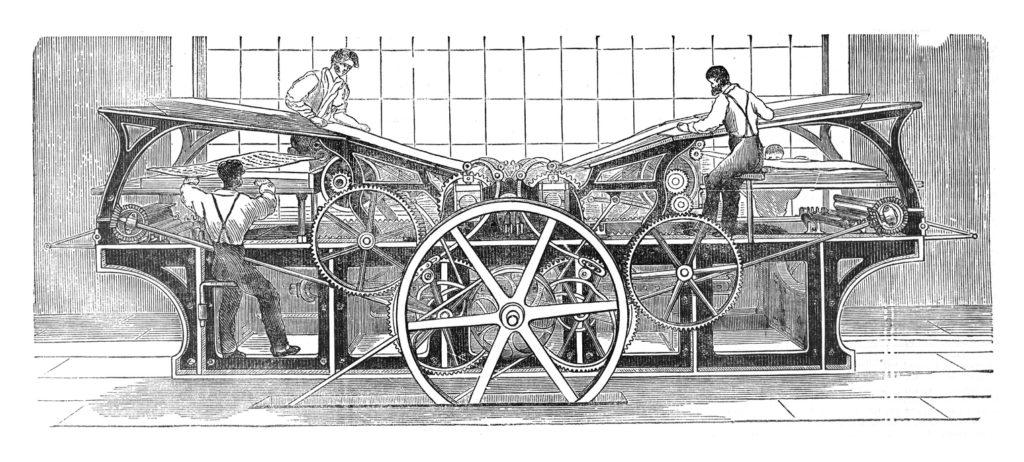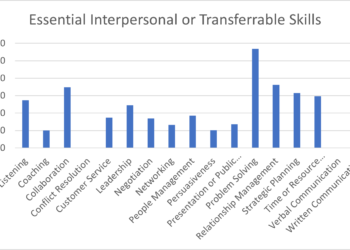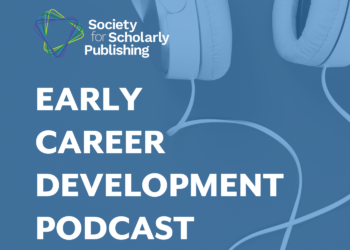Editor’s Note: Today’s post is by Charles Watkinson and Lisa Bayer. Charles is the Director of the University of Michigan Press and the 2022-2023 President of the Association of University Presses. Lisa is the Director of the University of Georgia Press and was the 2021-2022 President of the Association. Together they represent AUPresses as co-chairs of the Task Force on Career Progression — a joint initiative with the Society for Scholarly Publishing and the focus of this post. The Task Force invites contributions of position descriptions, and this post describes why.
Like super-adaptable tardigrades, mission-driven scholarly publishers thrive in an astonishing variety of habitats. In North America, these include public and private universities and colleges; military service academies; almost every learned society; museums and galleries; non-governmental organizations and think tanks; research institutes; and hundreds of libraries (from the largest, the Library of Congress, to the oldest, the American Philosophical Society). These publishers can be oriented toward generating financial surpluses or trying just to break even, committed to opening access or facilitating affordable restricted access. They produce journals, datasets, monographs, textbooks, trade books, and everything in between. The common feature that most of them share is that they embed scholarly publishing professionals within a larger organization whose primary business is not publishing.
Being an “embedded publisher” can be exciting, offering privileged opportunities to get involved in the process of research, not just its products. However, from a career progression perspective, it can be challenging: The parent organization may, at best, simply not know how to categorize publishers within their HR structures and, at worst, fail to respect the distinctive role publishing staff play as information professionals. Improving employment structures for embedded publishers is just one of the issues that the Society for Scholarly Publishing (SSP) and Association of University Presses (AUPresses) Joint Task Force on Career Progression, established in spring 2022, aims to address. This ambitious effort includes all scholarly publishing professionals – non-profit, commercial, embedded, and independent — and the opportunity for clarity it offers for embedded publishers like the university presses the two of us work at is only part of the picture.

When publishers work for universities and colleges, their jobs are often mapped to broad higher education schemas, such as the CUPA-HR Job Description Index or EduComp Compensation Survey. Publishing roles are poorly defined in these sources, leading to confusion within the career maps that individual institutions maintain. For example, the difference between an “acquisitions editor” and a “production editor” is obscured; the particular skills needed for marketing products rather than services are unclear; the expertise required to produce scholarly books and journals rather than newsletters and press releases is understated. Unmappable positions get lumped into large generic university work families such as “project manager intermediate,” within which meaningful benchmarking is almost impossible.
This situation contrasts with complementary groups of information professionals such as librarians and archivists who have built well-defined and structured employment ladders. The CUPA HR Job Description Index, for example, includes around thirty well-described “librarian” positions (partly due to the lobbying of professional library associations) but just one “university press” description. The EduComp Compensation Survey does better, but job coverage blurs functional differences (e.g., between acquisitions and production editorial). The survey also includes limited steps within job families and does not acknowledge specialized roles beyond the acquisitions and production departments (e.g., rights and permissions).
New entrants to publishing are often frustrated by the idiosyncratic, inconsistent, segmented, and insular nature of the job market. This is true of commercial and non-profit, trade and scholarly publishing alike. They are baffled by the opacity surrounding the skills necessary to enter and advance in the profession, frustrated by the relative scarcity of formal training opportunities, and demoralized by compensation decisions that do not have clear bases in evidence. These issues have been highlighted by several recent advocacy efforts, such as #BookJobTransparency.
Incumbent embedded publishers have often become resigned to this lack of structure. Witness frequent references to publishing as “the accidental profession.” The assumption that a publishing career is something one stumbles into can obscure entryways to individuals. If a student wants to prepare for a professional career in scholarly publishing, what steps should they take if the primary qualification is “it was an accident”? This is especially challenging if they lack the network or insider knowledge to conduct informational interviews with incumbents.
The lack of structure also perpetuates apprenticeship models for skills development that depend heavily on the mentor’s commitment and are sometimes vulnerable to their prejudices. Worse still, the concept of “apprenticeship” can be used to justify unsustainable starting pay. Crucially, if compensation for entry-level positions does not sustain a reasonable standard of living without external support, it perpetuates the lack of diversity among new entrants to the profession that has contributed to the homogeneity of the profession — as highlighted by the C4DISC Coalition for Diversity and Inclusion in Scholarly Communications.
Many members of SSP and AUPresses work within organizations that don’t generally know how to categorize them. These publishers’ frustration with the lack of structure is a motivating force for establishing the Joint Task Force on Career Progression. Thanks to the work of dedicated volunteers, the expertise of SSP and AUPresses staff members Jacklyn Lord and Brenna McLaughlin, the guidance of HR professionals, and the consultancy of University of Michigan labor economics doctoral candidate Michelle Lam, the Task Force is developing a database of well-formatted descriptions of mission-driven publishing, highlighting the skills needed to both enter the profession and advance a career. In 2023, we plan to release a database of anonymized positions in a form that can also inform generalized higher education data sources and ensure that structural change sticks.
While the current Task Force won’t address compensation scales, the hope is that creating a solid understanding of what positions exist and how they relate to each other will complement initiatives focused on pay. These include grassroots efforts such as the Paths in Publishing Pay Database and formal tools such as the AUPresses biennial Compensation Survey (distributed to member presses). Steps to make salaries more transparent have been helpfully summarized by Taskforce member Amy Sherman in the H-Net “Feeding the Elephant” forum for scholarly communications.
Will clarity of job descriptions result in better pay in the aggregate for publishing professionals embedded in institutions? No, not on its own. University press publishing is a systematically underpaid field for larger structural reasons, such as how university presses are usually classified in higher education as financially underperforming “auxiliary” units rather than part of the institution’s core mission and funded accordingly. However, articulating position descriptions for the informational professionals working as publishers alongside the often better-compensated information professionals working as librarians, archivists, or curators (on the one hand) and in the commercial publishing sector (on the other hand) should at least open up the conversation among administrators.
The work of creating a database of publishing position descriptions builds on the Professional Skills Map, developed by the SSP Career Development Committee and highlighted in a previous 2022 Scholarly Kitchen post. Thanks to a dedicated methodology subcommittee led by Jacklyn Lord, the position descriptions in the database will be mapped to the SSP Professional Skills Map and the O*Net taxonomy developed with sponsorship from the US Department of Labor. This mapping work will help individuals interested in scholarly publishing evaluate how their skills translate to various jobs and what skills they must develop to progress once hired.
An emphasis on skills should help individuals to break out of silos and move between functions in publishing. Early career professionals (such as editorial assistants) can get marooned if the assumption is that there is only one path for progression; through acquisitions. A structure that helps them map their skills to other potential career pathways should lead to better retention and job satisfaction. Mid-career professionals often encounter the challenge that the only path to further progression is taking on supervisory responsibilities, whereas their most significant contribution may come from other forms of expertise. A classic example of this is the designation “Executive Editor.” This title is firmly embedded in university press culture as describing an individual who excels in the art of acquisitions editorial and should be given the time to focus on such work. However, the concept is absent from the HR classification schema that directors need to reference when justifying their requests for compensation reviews.
Well-categorized positions and clear promotional pathways within them are essential for employers committed to equitable decision-making and for employees who deserve fair compensation and paths to advancement. Clearly articulating the skills needed to do different jobs in publishing also helps embedded publishers get respect from their peers as a distinct group of informational professionals. University presses, for example, have robust professional cultures, but these are not well-recognized outside the publishing field. This lack of recognition can lead to a corrosive lack of respect, especially when university administrators change organizational structure and place university press employees side-by-side with other university employees, such as librarians, whose professional cultures emphasize hierarchy and tightly documented paths to advancement.
In the last decade, the number of university presses reporting to libraries has more than doubled. A third of the North American university press members of the Association of University Presses now report to libraries. Transitions in organizational reporting lines have often been accompanied by tension, sometimes bubbling up to hit national headlines. Can a librarian with no professional background in publishing lead a university press? Can core functions such as acquisitions or production editorial be incorporated into the roles of existing library staff? Missteps in these areas could have been avoided if university press position descriptions had been as adequately described in university HR structures as librarianship is. As it is, such moves too frequently have led to long-running resentments that inhibit the opportunities for deep collaboration between the two main centers of scholarly communication expertise on campus.
The Task Force’s success is predicated on compiling a robust dataset. Over 3,000 job postings and position descriptions have so far been contributed and are currently being classified and converted into a template form that anonymizes them and structures the data consistently. Some have been exported from recruitment sites, such as the Association of University Presses Job List, and a significant windfall came when Jack Farrell & Associates Executive Search, a leading publishing recruiter, generously donated its carefully curated list of public position postings. But the richest source has been contributions made by helpful individuals through a simple online form that is still open for contributions. Please consider contributing your position description and, if appropriate, multiple position descriptions from your organization. As the submission form makes clear, all contributed descriptions are fully anonymized before sharing occurs. All publishing job descriptions, whether embedded or not, both commercial and non-profit, are gratefully received and will contribute to the strength of this initiative.
Discussion
1 Thought on "Guest Post — Beyond the “Accidental Profession”: Bringing More Structure, Equity, and Respect to Scholarly Publishing Employment"
Excellent article! Besides being on the bleeding edge of cultural production and part of a by-and-large wonderful community, the world of scholarly publishing is also a career path fraught with frustrations. Although publishing programs have been growing (at least in North America), it is an eclectic community of lost souls, as the label ‘the accidental profession’ suggests, who have found a home here. It is worth mentioning, as my old friend and mentor Helmut Schwarzer taught me long ago, this has not been the case everywhere – Germany has always had programs for the professional study of publishing and bookselling (often under the name *Buchwissenschaft*).


